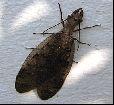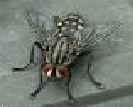Natural Solutions to Things That Bug You (55 page)
Read Natural Solutions to Things That Bug You Online
Authors: Myles Bader

Both male and female dobsonflies have very sharp mandibles, those of an adult male dobsonfly are actually so big (up to 1 inch 25 mm) that they are unable to harm humans, as they have such poor leverage that they are incapable of breaking the skin. Their mandibles are used exclusively during mating, where males show them off and grasp the females during copulation.
Female dobsonflies, however, retain the short, powerful pincers they had as larvae, so they can inflict painful bites, which can draw blood. Both sexes will raise their heads and spread their jaws menacingly when they perceive danger. They are not venomous, but possess an irritating, foul-smelling anal spray as a last-ditch defense.
Dobsonflies spend most of their life in the larval stage, during which they are called hellgrammites and are familiar to fishermen who like to use the large larvae as bait. They live under rocks at the bottoms of lakes and streams and prey on other insect larvae with the short sharp pincers on their heads, with which they can also inflict painful bites on humans.
The larvae reach to 2" to 3" in length, with gills all along the sides of their segmented bodies that allow them to extract oxygen from water.
After a few years of living and growing underwater, the larvae crawl out onto land and pupate. They stay in their cocoons over the winter and emerge only to mate. Upon emerging, they live for only seven days.

FACE FLY
 The face fly, which closely resembles the house fly, attacks livestock chiefly on the head and face. Face flies are of primary economic importance as an annoyance to cattle, horses and less frequently to swine. On cattle, a disruption of grazing, poor utilization of feedstuffs with subsequent weight loss or reduced milk production, and diseases can occur when fly populations are not controlled.
The face fly, which closely resembles the house fly, attacks livestock chiefly on the head and face. Face flies are of primary economic importance as an annoyance to cattle, horses and less frequently to swine. On cattle, a disruption of grazing, poor utilization of feedstuffs with subsequent weight loss or reduced milk production, and diseases can occur when fly populations are not controlled.
Face flies have been implicated in the transmission of conjunctivitis (pinkeye), infectious abortion and eyeworm in cattle. Beef and dairy cattle, horses and open-faced sheep are the principal animals bothered by this pest. They feed, without piercing the skin, upon the mucous secretions around the eyes, nose and lips and upon fresh wounds or saliva deposits on the shoulders, neck and legs.
Face flies are about 20 percent larger than house flies, being slightly longer and more robust. The adults are active from early spring to late autumn with only females normally being found on cattle and horses. Males frequent and feed on pollen produced by flowering vegetation. At night, both sexes are found resting on inanimate objects.
The face fly overwinters as an adult, hibernating in protected places such as building lofts and attics. Here, they can become a serious domestic pest by crawling on walls, windows and floors during winter warm spells and when they become active just before leaving the hibernation site. The flies mate shortly after becoming active in early spring. During this time flies congregate in sunny spots on high buildings near ventilator opening or cracks and crevices.
Adult face flies will feed on several kinds of large mammals, but do not lay eggs in or develop naturally in the manure of any animals except cattle. Furthermore, female face flies lay their eggs only in freshly deposited cow manure prior to crust formations, particularly that from animals on rangeland or pasture.
Face flies do not lay eggs in manure piles around barns and stables or in the disturbed, urine-saturated and trampled droppings usually associated with beef feedlots and dry lots.
In the manure, eggs hatch in about one day, and the larvae complete their development in 2½ to 4 days. As the larvae mature, they turn from white to yellow and move to the soil adjacent to the cow manure where they enter the pupae stage and in 5 to 7 days, they emerge as adults. The entire life cycle is completed in about 2 weeks, and numerous generations per year may occur, depending upon climate conditions.
FLESH FLIES
 Flesh Flies usually seek scraps of meat on which to lay their eggs. Similar to house flies, adult flesh flies are dark-colored (gray or black). Common species have three dark stripes on the thorax and are slightly larger than house flies with a checkerboard pattern on the abdomen.
Flesh Flies usually seek scraps of meat on which to lay their eggs. Similar to house flies, adult flesh flies are dark-colored (gray or black). Common species have three dark stripes on the thorax and are slightly larger than house flies with a checkerboard pattern on the abdomen.
Flesh flies are often mistaken for houseflies due to their coloration and markings. However, their gray-checkered abdomens are larger than those of the housefly. A flesh fly exhibits three dark stripes along the prothorax and four distinct bristles on top of the thorax. An extra row of bristles is also found beneath the flesh fly's wings and yet another can be found at each side of the thorax.
Flesh flies measure approximately ½-inch from end to end. Larvae are yellow in color, with pointed heads. Along with bottle and blowflies, flesh flies prove useful to forensic entomologists. These fly larvae may assist in pinpointing time of death. Flesh flies reproduce on decaying vegetable items, animal flesh, carcasses, garbage and excrement.
Although flesh flies do not bite and are not carriers of disease, their feeding habits can become a nuisance.
However, larvae can also prove beneficial to humans, as they prey on the eggs and larvae of other pests such as grasshoppers, blowflies, houseflies, spiders and snails. Flesh flies are rarely found in homes or restaurants. Infestations in these locations are most likely due to a different fly species.
FRUIT FLIES
General Information:
 If you see small flies or gnats in your kitchen, they're probably fruit flies. Fruit flies are a problem year round, but are more common during late summer and into fall because they are attracted to ripened or fermenting fruits and vegetables.
If you see small flies or gnats in your kitchen, they're probably fruit flies. Fruit flies are a problem year round, but are more common during late summer and into fall because they are attracted to ripened or fermenting fruits and vegetables.
Tomatoes, melons, grapes and other perishable items brought in from the garden are often the cause of an infestation developing indoors.
Fruit flies are also attracted to very ripe bananas, potatoes, onions and other unrefrigerated produce. Fruit flies are very common in homes, restaurants, supermarkets and wherever food is allowed to rot and ferment. The adult fly is about 1/8 inch long and usually has red eyes. The front portion of the body is tan and the rear portion is black.
Fruit flies will lay their eggs near the surface of fermenting foods or other moist, organic materials. When the tiny larvae, emerges it will continue to feed near the surface of the fermenting mass.
This surface-feeding characteristic of the larvae is significant in that damaged or over-ripened portions of fruits and vegetables can be removed without having to discard the remainder for fear of retaining any developing larvae.
The reproductive potential of fruit flies is enormous; if given the opportunity, they will lay about 500 eggs and the entire lifecycle from egg to adult can be completed in about a week. They also will breed in drains, garbage disposals, empty bottles and cans, trash containers, and cleaning rags. All that is needed for development is a moist film of fermenting material.
Infestations can originate from over-ripened fruits or vegetables that were previously infested and brought into the home. The adults can also fly in from outside through inadequately screened windows and doors.
Fruit flies are primarily nuisance pests; however, they also have the potential to contaminate food with bacteria and other disease-producing organisms.
Once your home is infested with fruit flies, all potential breeding areas must be located and eliminated. Unless the breeding sites are removed or cleaned, the problem will continue no matter how often natural insecticides are applied to control the adults.

A LITTLE SQUIRT
If you own birds and feed them fruit you may develop a fruit fly problem. There is a pyrethrum aerosol spray that is safe to use around birds called Misty Miser XX™.
This will work as a short-term problem solver, but removing the food supply is the best answer. This spray is also one of the best methods of ridding your yard of flies.
FRUIT FLY LURE
Citronella grass is very effective in luring fruit flies into a glue-coated trap. If you have a problem with crops, just spray them with a diluted citronella oil spray.
GRAIN WILL KILL FRUIT FLIES
If you crush 1 cup of the grass-like grain called finger millet and place the powder in 1-quart of warm water then spray it works great for small areas or just a few trees.
MAKING FLYPAPER WITH HONEY
The following ingredients will be needed:
9 Parts rosin
3 Parts canola oil
1 Part honey
Place all the ingredients into a saucepan and melt together, stir well and apply to the paper while still warm. The paper should be prepared cutting strips of paper and folding them over and stapling them so that they will strong. Size the paper with shellac or varnish to prevent the mixture from spreading too far.
Keep away from children and pets.